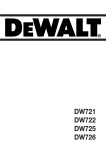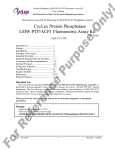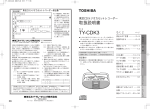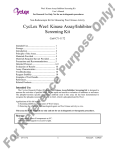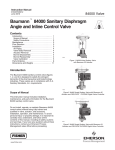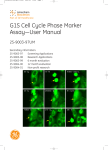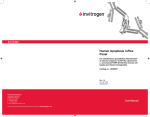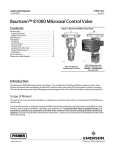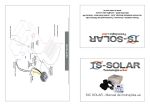Download CY-1356 Protein Phosphatase Cdi1/KAP Fluorometric Assay Kit
Transcript
On Fluorometric Assay Kit for Measuring Cdi1/KAP Phosphatase Activity ly ! Protein Phosphatase Cdi1/KAP Fluorometric Assay Kit User’s Manual For Research Use Only, Not for use in diagnostic procedures CycLex Protein Phosphatase Cdi1/KAP Fluorometric Assay Kit en ce Pu Intended Use............................................ 1 Storage..................................................... 1 Introduction ............................................. 2 Principle of the Assay.............................. 2 Materials Provided .................................. 3 Materials Required but not Provided.….. 3 Precautions and Recommendations......... 3-4 Detailed Protocol..................................... 4-6 Evaluation of Results .............................. 7-9 Troubleshooting ...................................... 10 Reagent Stability ..................................... 10 References............................................... 11 Related Products...................................... 11-12 rp Cat# CY-1356 os e 100 Assays Intended Use The CycLex Research product Protein Phosphatase Cdi1/KAP Fluorometric Assay Kit is a fluorometric and non-radioactive assay designed to measure the activity of Cdi1/KAP protein phosphatase. This 96-well assay is useful for screening inhibitors and modulators of Cdi1/KAP activity in HTS. The kit includes all necessary components, including recombinant, human Cdi1/KAP (full length), for use in preinvestigational drug discovery assays. er This assay kit is for research use only and not for use in human, diagnostic, or therapeutic procedures. Storage rR ef • Upon receipt, store the kit at -70°C. • Don’t expose reagents to excessive light. • AVOID REPEATED FREEZE THAW CYCLES OF“③Recombinant Cdi1/KAP”! Fo Cat#: CY-1356 1 Version#: 120420 On Introduction ly ! Protein Phosphatase Cdi1/KAP Fluorometric Assay Kit User’s Manual For Research Use Only, Not for use in diagnostic procedures rp os e A Cdk-interacting protein called Cdi1 (cyclin-dependent kinase interactor 1)/KAP (kinase associated phosphatase) was first identified as a novel G1- and S-phase dual-specificity phosphatase that associates with Cdk2 and/or Cdc2 by the interaction trap, a yeast genetic selection for interacting proteins (1, 2). Using yeast two hybrid system, Cdi1/KAP interacts with cyclin-dependent kinases, including human Cdc2, Cdk2 and Cdk3, but not with Cdk4. In HeLa cells, Cdi1/KAP is expressed at the G1 to S transition, and the protein forms stable complexes with Cdk2. Further studies demonstrated that Cdi1/KAP binds to Cdk2 and dephosphorylates Thr160 when the associated cyclin subunit is degraded or dissociated (3). It means that Cdi1/KAP may inactivate a Cdk2 or Cdc2, by removing phosphates from the cyclin complexes, and this may contribute to cell cycle control (2). However, the physiological substrate(s) for tyrosine dephosphorylation of Cdi1/KAP has not yet been identified. Phosphatases have also been shown to play an important role in regulating a variety of signal transduction pathways that have a bearing on cancer (4-6). It was reported that the Cdi1/KAP gene is overexpressed in human breast and prostate cancer using differential screening and that breast and prostate malignancies are associated with high levels of KAP expression (7). Principle of the Assay en ce Summary of Procedure Pu The Protein Phosphatase Cdi1/KAP Fluorometric Assay Kit is based on an exclusive fluorescence substrate, OMFP (3-o-methylfluorescein phosphate). This homogenous assay kit is sensitive and convenient. This method of measurement should raise the efficiency of inhibitor screening and biochemical analysis of this enzyme. Mix 40 µL of Assay mixture and 5 µL of test compound in the wells Add 5 µL of Recombinant Cdi1/KAP Incubate for 15 min at room temp. Add 25 µL of Stop Solution rR ef er Measure fluorescence at 510-540 nm emission / 482-502 nm excitation Fo Cat#: CY-1356 2 Version#: 120420 On Materials Provided ly ! Protein Phosphatase Cdi1/KAP Fluorometric Assay Kit User’s Manual For Research Use Only, Not for use in diagnostic procedures All samples and standards should be assayed in duplicate. The following components are supplied and are sufficient for one hundred assays. Components of Kit 10X Assay Buffer 10X 3-o-methyl fluorescein phosphate (OMFP) Recombinant Cdi1/KAP, Human (0.4 µg/µL) 100X Cdi1 Inhibitor : 100 µM Na3VO4 in H2O Stop Solution Instruction Manual rp ① ② ③ ④ ⑤ ⑥ Quantity 600 µL x 1 550 µL x 1 550 µL x 1 100 µL x 1 300 µL x 1 1 Storage Below -20°C Below -20°C -70°C Below -20°C Below -20°C Room temp. os e Components Materials Required but not Provided en ce Pu • Microtiter plate suitable for use with a fluorometric plate reader • Fluorometric plate reader or microtiter plate fluorometer: Use a fluorescence microplate reader equipped with appropriate filters. OMFP has excitation/emission maxima of approximately 485/525 nm. We have found that standard filters for blue-fluorescent dyes (e.g., excitation = 485 ±12.5 nm, emission = 525 ± 20 nm) can be used to detect OMFP. • Pipettors: 2-20 µL, 20-200 µL and 200-1000 µL precision pipettors with disposable tips • Multi-channel pipette • Microtiter plate shaker • Distilled water (DW) or equivalent high quality water • Microcentrifuge and tubes for sample preparation • Reagent reservoirs • Ice bucket to keep reagents cold until use Precautions and Recommendations • Upon receipt, store the kit at -70°C. er • Do not expose reagents to excessive light. • Do not use kit components beyond the indicated kit expiration date. ef • Rinse all detergent residue from glassware. • Use deionized water of the highest quality. rR • Do not mix reagents from different kits. • Do not mouth pipette or ingest any of the reagents. • Do not smoke, eat, or drink when performing the assay or in areas where samples or reagents are handled. Fo Cat#: CY-1356 3 Version#: 120420 On ly ! Protein Phosphatase Cdi1/KAP Fluorometric Assay Kit User’s Manual For Research Use Only, Not for use in diagnostic procedures NOTE: THE FOLLOWING PROCEDURES ARE INTENDED ONLY AS A GUIDELINE. THE OPTIMAL EXPERIMENTAL CONDITIONS WILL VARY DEPENDING ON THE PARAMETERS BEING INVESTIGATED, AND MUST BE DETERMINED BY THE INDIVIDUAL USER. os e Detailed Protocol Preparation of Reagents Thaw the reagents at room temperature except “Recombinant Cdi1/KAP” and keep all reagents on ice until use. Use them only after they are completely thawed and mixed. rp 1. Prepare 10X Cdi1 Inhibitor by adding 5 µL of the ④ 100X Cdi1 Inhibitor (provided) to 45 µL of distilled (deionized) water. Mix well. Discard any unused 10X Cdi1 Inhibitor after use. Assay Mixture Assay reagents Pu 2. Prepare Assay Mixture by adding 5 µL of the ①10X Assay Buffer (provided) and 5 µL of the 10X Fluoro-Phospho-Substrate (provided) to 30 µL of distilled (deionized) water per one assay. Mix well. 1 assay 8 assays 16 assays 32 assays 48 assays 30 µL 5 µL 5 µL 240 µL 40 µL 40 µL 480 µL 80 µL 80 µL 960 µL 160 µL 160 µL 1,440 µL 240 µL 240 µL Total volume of Assay Mixture 40 µL 320 µL 640 µL 1,240 µL 1,920 µL rR ef er en ce Distilled water ①10X Assay Buffer ②10X OMFP Fo Cat#: CY-1356 4 Version#: 120420 On Assay Procedure ly ! Protein Phosphatase Cdi1/KAP Fluorometric Assay Kit User’s Manual For Research Use Only, Not for use in diagnostic procedures os e In order to estimate the inhibitory effect on Cdi1/KAP activity by the test compounds correctly, it is necessary to conduct the control experiment of “Vehicle control” at least once for every experiment and “Inhibitor control” at least once for the first experiment, in addition to “Test sample” as indicated in the Table.1 (below). When test chemicals cause an inhibitory effect on Cdi1/KAP activity, the level of increase of fluorescence intensity is weakened as compared with “Vehicle control”. The increase in fluorescence intensity is not observed in “Inhibitor control”. 1. Following Table.1 below, first, add “Assay mixture” to microtiter plate wells. Second, add “Test Compound” or “Vehicle of Test Compounds” or “10X Cdi1 Inhibitor” to each well of the microtiter plate and mix well. Table.1: Reaction mixture Vehicle Control Inhibitor No Enzyme Control Control Assay Mixture 40 µL 40 µL 40 µL 40 µL Test Compound Vehicle of Test Compounds 10X Cdi1 Inhibitor* 5 µL - 5 µL - 5 µL 5 µL - 5 µL - 5 µL - 5 µL - 5 µL 50 µL 50 µL 50 µL rp Test Sample Pu Assay reagents en ce ③Recombinant Cdi1/KAP (0.1µg/µL) Distilled water Total Volume of the Reaction mixture 50 µL *10X Cdi1 Inhibitor (10 µM Na3VO4): See Page 4, section Preparation of Reagents 2. Initiate reactions by adding 5 µL of “③Recombinant Cdi1/KAP” or distilled water to each well and mixing thoroughly at room temperature. er 3. Incubate for 15 min or desired length of time at room temperature. 4. Add 25 µL of “⑤Stop Solution” to each well of the microtiter plate, and mix thoroughly. ef 5. Measure fluorescence intensity using a microtiter plate fluorometer with excitation at 482-502 nm and emission at 510-540 nm. 6. The efficacy of the Test compound is the difference in fluorescence intensity between “Vehicle control” and “Test sample”. rR Note: If necessary, it is possible to store the microtiter plate after adding “④Stop Solution” for a few hours at 4°C. The microtiter plate must be sealed to prevent evaporation and kept from excessive light. Fo Cat#: CY-1356 5 Version#: 120420 On Alternate procedure ly ! Protein Phosphatase Cdi1/KAP Fluorometric Assay Kit User’s Manual For Research Use Only, Not for use in diagnostic procedures 1’. Following Table.1 above, first, add “Assay mixture” to microtiter plate wells. Second, add “Test Compound” or “Vehicle of Test Compounds” or “10X Cdi1/KAP Inhibitor” to each well of the microtiter plate and mix well. os e 2’. Initiate reactions by adding 5 µL of “③Recombinant Cdi1/KAP” or distilled water to each well and mixing thoroughly at room temperature. 3’. Read fluorescence intensity for 20 to 30 minutes at 1 to 2 minute intervals using microtiter plate fluorometer with excitation at 482-502 nm and emission at 510-540 nm. 4’. Measure and calculate the rate of reaction while the reaction velocity remains constant. rp Caution and Significance • All samples and “Recombinant Cdi1/KAP” should be assayed in duplicate. Pu • Use of a microtiter plate shaker is recommended for complete mixing. rR ef er en ce • If the test compounds or samples themselves emit fluorescence at excitation wavelength: 482-502 nm and fluorescence wavelength: 510-540 nm, the test assay cannot be evaluated correctly. Fo Cat#: CY-1356 6 Version#: 120420 On Evaluation of Results ly ! Protein Phosphatase Cdi1/KAP Fluorometric Assay Kit User’s Manual For Research Use Only, Not for use in diagnostic procedures Analysis of Inhibitor Effect #1 % Intensity os e 1. Run reactions with test compounds and Vehicle as described in the Detailed Protocol. 2. Subtract fluorescence intensity of “No Enzyme Control” from all experimental samples (Test Samples and Vehicle Control). 3. Calculate the % Intensity: Fluorescence Intensity of Test Sample X 100 Fluorescence Intensity of Vehicle Control rp % Intensity = Pu Note: This % Intensity is a rough value of enzyme activity or inhibition. For greater accuracy, plot a standard curve of Cdi1/KAP for each new set of reactions and estimate the % Activity (see below). Fig.1 Cdi1/KAP Inhibition Curve by Na3VO4 (Na3VO4;Sodium Orthovanadate) en ce 100 80 60 40 er relative intensity (%) 120 20 rR ef 0 0.0001 Fo Cat#: CY-1356 0.001 0.01 0.1 1 10 100 1000 10000 N a3VO 4 conc.(u M) 7 Version#: 120420 On Analysis of Enzyme Activity ly ! Protein Phosphatase Cdi1/KAP Fluorometric Assay Kit User’s Manual For Research Use Only, Not for use in diagnostic procedures Cdi1/KAP Standard Curve and % Activity os e 1. Dilute the ①10X Assay buffer 1:10 with distilled water to make 1X Assay Buffer. 2. Make serial dilutions of Recombinant Cdi1/KAP with 1X Assay Buffer (ex. 100%, 50%, 25%, 12.5% 6.25% , 3.13% and 0%). 3. Run reactions with Vehicle and serial dilutions of Recombinant Cdi1/KAP as described in the Detailed Protocol. 4. Plot standard curve data (dose dependent curve data) as fluorescence intensity at 510-540 nm versus dose of Cdi1/KAP (ng/assay) 5. Obtain a line-fit to the data using appropriate calculations. 6. Use the slope and Y-intercept to calculate the amount of Cdi1/KAP activity for the experimental data. Pu rp Fig.2 Dose Dependency of Recombinant Cdi1/KAP 3,000,000 2,000,000 en ce c o u n t s(4 8 5 / 5 3 5 ) 2,500,000 1,500,000 1,000,000 500,000 0 0.1 1 di l uti on ra ti o rR ef er 0.01 Fo Cat#: CY-1356 8 Version#: 120420 On Analysis of Kinetics ly ! Protein Phosphatase Cdi1/KAP Fluorometric Assay Kit User’s Manual For Research Use Only, Not for use in diagnostic procedures Time Course Curve os e 1. Run reactions as described in the Detailed Protocol. 2. Subtract fluorescence intensity at the 0 time from all reaction time points. 3. Plot fluorescence intensity at 510-540 nm versus reaction time. 4. Determine the reaction time range in which the increase in fluorescence intensity at 510-540 nm is linear. 5. Calculate activity: Fluorescence Intensity of Test Sample Activity (reaction velocity) = rp Reaction time (min.) Pu Note: Usually, the linear range is from 0 to 30 min. This value is variable depending on reaction conditions and storage/handling of the Recombinant Cdi1/KAP. Decreasing the amount of Recombinant Cdi1/KAP in the assay may help to lengthen the time range. Fig.3 Time Course Curve of Recombinant Cdi1/KAP en ce 2,500,000 1,500,000 1,000,000 er c o u n t s(48 5 / 5 3 5 ) 2,000,000 500,000 ef 0 rR 0.0 Fo Cat#: CY-1356 15.0 30.0 45.0 60.0 Ti me( mi n.) 9 Version#: 120420 On Troubleshooting ly ! Protein Phosphatase Cdi1/KAP Fluorometric Assay Kit User’s Manual For Research Use Only, Not for use in diagnostic procedures 1. The Recombinant Cdi1/KAP should be run in duplicate using the protocol described in the Detailed Protocol. Incubation times or temperatures significantly different from those specified may give erroneous results. os e 2. The reaction curve is nearly a straight line if the kinetics of the assay is of the first order. Variations in the protocol can lead to non-linearity of the curve, as can assay kinetics of other than first order. For a non-linear curve, point to point or quadratic curve fit methods should be used. 3. Poor duplicates, accompanied by elevated values for wells containing no sample, indicate inaccurate dispensing of assay reagents. If all instructions in the Detailed Protocol were followed accurately, such results indicate a need for multi-channel pipette maintenance. rp Reagent Stability Pu All of the reagents included in the Protein Phosphatase Cdi1/KAP Fluorometric Assay Kit have been tested for stability. Reagents should not be used beyond the stated expiration date. Upon receipt, all kit reagents, except Recombinant Cdi1/KAP, should be stored at -20°C. Recombinant Cdi1/KAP should be stored at -70°C. After use, return kit reagents to -20°C as soon as possible. rR ef er en ce For research use only, not for use in human, diagnostic or therapeutic procedures Fo Cat#: CY-1356 10 Version#: 120420 On References ly ! Protein Phosphatase Cdi1/KAP Fluorometric Assay Kit User’s Manual For Research Use Only, Not for use in diagnostic procedures 1. Gyuris, J.; Golemis, E.; Chertkov, H.; Brent, R. Cdi1, a human G1 and S phase protein phosphatase that associates with Cdk2. Cell, 75: 791-803, 1993. os e 2. Hannon, G. J.; Casso, D.; Beach, D. KAP: a dual specificity phosphatase that interacts with cyclin-dependent kinases. Proc. Nat. Acad. Sci. 91: 1731-1735, 1994. 3. Poon RY and Hunter T. Dephosphorylation of Cdk2 Thr160 by the cyclin-dependent kinase-interacting phosphatase KAP in the absence of cyclin. Science, 270: 90-3, 1995. 4. Denu, J. M., M. A. Stuckey, M. Saper, and J. E. Dixon. Form and function in protein dephosphorylation. Cell, 87: 361-364, 1996. rp 5. Kinzler, K. W., and B. Vogelstein. Landscaping the cancer terrain. Science, 280: 1036-1037, 1998. 6. Parsons, R. Phosphatases and tumorigenesis. Curr. Opin. Oncol. 10: 88-91, 1998. Related Products Pu 7. Lee SW, Reimer CL, Fang L, Iruela-Arispe ML, Aaronson SA. Overexpression of kinase-associated phosphatase (KAP) in breast and prostate cancer and inhibition of the transformed phenotype by antisense KAP expression. Mol Cell Biol. 20: 1723-32, 2000. en ce * CycLex Protein Tyrosine Phosphatase 1B (PTP1B) Fluorometric Assay Kit: Cat# CY-1350 * CycLex T Cell Protein Tyrosine Phosphatase (TC-PTP) Fluorometric Assay Kit: Cat# CY-1351 * CycLex Protein Phosphatase Cdc25A Fluorometric Assay Kit: Cat# CY-1352 * CycLex Protein Phosphatase Cdc25B Fluorometric Assay Kit: Cat# CY-1353 * CycLex Protein Phosphatase Cdc25C Fluorometric Assay Kit: Cat# CY-1354 * CycLex Protein Phosphatase Cdc25 Combo Fluorometric Assay Kit: Cat# CY-1355 * CycLex Protein Phosphatase Cdi1/KAP Fluorometric Assay Kit: Cat# CY-1356 * CycLex Protein Phosphatase LMW-PTP/ACP1 Fluorometric Assay Kit: Cat# CY-1358 * CycLex Protein Phosphatase DUSP1/MKP-1 Fluorometric Assay Kit: Cat# CY-1373 rR ef er * Protein Tyrosine Phosphatase PTPRA 1st Catalytic Domain: Cat# CY-E1301 * Protein Tyrosine Phosphatase PTPRA 2nd Catalytic Domain: Cat# CY-E1302 * Protein Tyrosine Phosphatase PTPRD 2nd Catalytic Domain: Cat# CY-E1307 * Protein Tyrosine Phosphatase PTPRE 1st Catalytic Domain: Cat# CY-E1308 * Protein Tyrosine Phosphatase PTPRF 1st Catalytic Domain: Cat# CY-E1310 * Protein Tyrosine Phosphatase PTPRK 1st Catalytic Domain: Cat# CY-E1316 * Protein Tyrosine Phosphatase PTPRQ: Cat# CY-E1323 * Protein Tyrosine Phosphatase PTP4A2: Cat# CY-E1341 * Recombinant Cdc25A (Catalytic domain): Cat# CY-E1352 * Recombinant Cdc25B (Catalytic domain): Cat# CY-E1353 * Recombinant Cdc25C (Catalytic domain): Cat# CY-E1354 * Recombinant Cdi1/KAP: Cat# CY-E1356 * Protein Phosphatase PP5: Cat# CY-E1359 * Protein Tyrosine Phosphatase PTPN3/PTPH1: Cat# CY-E1360 * Protein Tyrosine Phosphatase PTPN6/SHP-1: Cat# CY-E1363 * Protein Tyrosine Phosphatase PTPN7/HePTP: Cat# CY-E1364 Fo Cat#: CY-1356 11 Version#: 120420 ly ! en ce Pu rp os e * Protein Tyrosine Phosphatase PTPN8/PTPN22: Cat# CY-E1365 * Protein Tyrosine Phosphatase PTPN9/MEG2: Cat# CY-E1366 * Protein Tyrosine Phosphatase PTPN11/SHP-2: Cat# CY-E1367 * Protein Tyrosine Phosphatase PTPN12/PTP-PEST: Cat# CY-E1368 * Protein Tyrosine Phosphatase PTPN13/FAP-1: Cat# CY-E1369 * Protein Tyrosine Phosphatase PTPN14/PEZ: Cat# CY-E1370 * Protein Tyrosine Phosphatase PTPN21/PTPD1: Cat# CY-E1372 * Protein Phosphatase DUSP1/MKP-1: Cat# CY-E1373 On Protein Phosphatase Cdi1/KAP Fluorometric Assay Kit User’s Manual For Research Use Only, Not for use in diagnostic procedures PRODUCED BY ef er CycLex Co., Ltd. 1063-103 Terasawaoka Ina, Nagano 396-0002 Japan Fax: +81-265-76-7618 e-mail: [email protected] URL: http://www.cyclex.co.jp rR CycLex/CircuLex products are supplied for research use only. CycLex/CircuLex products and components thereof may not be resold, modified for resale, or used to manufacture commercial products without prior written approval from CycLex Co., Ltd.. To inquire about licensing for such commercial use, please contact us via email. Fo Cat#: CY-1356 12 Version#: 120420















